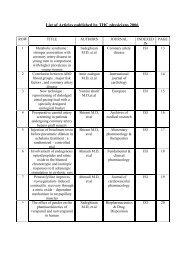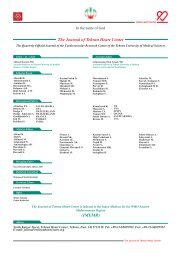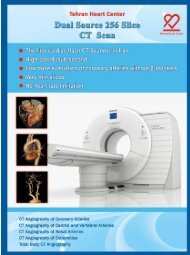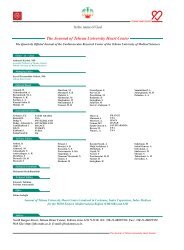Metabolic Syndrome: Stronger association With Coronary Artery
Metabolic Syndrome: Stronger association With Coronary Artery
Metabolic Syndrome: Stronger association With Coronary Artery
Create successful ePaper yourself
Turn your PDF publications into a flip-book with our unique Google optimized e-Paper software.
Berif Communication<br />
Percutaneous Repositioning<br />
of Dislodged Atrial Pacing Lead<br />
Ahmad Yamini Sharif, MD * , Gholamreza Davoodi, MD<br />
Tehran Heart Center, Tehran University of Medical Sciences, Tehran, Iran.<br />
Abstract<br />
Received 20 February 2006; Accepted 6 June 2006<br />
The overall rate of atrial pacing lead dislodgement is estimated to be about 3%. These leads are generally repositioned<br />
via a second operation through opening the pacemaker pocket.<br />
Some operators have introduced percutaneous techniques using snare system or deflectable catheters for this purpose.<br />
In this article we present our experience with five cases of percutaneous lead repositioning. Three cases were performed<br />
using deflectable ablation catheters and in two cases we used a specially designed urologic basket. The procedural success<br />
rate was 100% at the beginning but the long term success rate was 60%.<br />
The Journal of Tehran Heart Center, V 1, N 2 (2006) 109-112<br />
Keywords: Atrial pacing lead • Dislodgement • Urologic basket • Percutaneous repositioning<br />
Introduction<br />
Lead dislodgement requiring reoperation is a complication<br />
that raises the costs of pacemaker implantation surgery while<br />
adding to patient’s discomfort. Migration of a dislodged atrial<br />
lead can present with undersensing, loss of atrial capture,<br />
loss of atrial kick in patients who need AV synchrony and<br />
rarely phrenic nerve stimulation or improper RV stimulation.<br />
Once detected, the dislodged lead should be immediately<br />
repositioned. 1,2<br />
In recent years, percutaneous transcatheter repositioning<br />
of displaced permanent pacemaker leads has been advocated<br />
before consideration of surgical repositioning. The procedure<br />
is easy and safe, allowing a reduction in the need for surgical<br />
lead revision and the associated morbidity and costs. 3,5 In this<br />
article we introduce five cases of dislodged atrial leads. In<br />
three cases we tried repositioning with deflectable ablation<br />
catheter and in two cases we used a specially designed<br />
urologic basket.<br />
Methods<br />
Cases performed by deflectable ablation catheters<br />
Three patients, who had atrial lead dislodgment and were<br />
diagnosed early in post implantation follow up, were selected<br />
for this procedure.<br />
In two cases the atrial lead was dislodged to SVC. In both<br />
cases we were able to reposition the lead successfully but in<br />
one of them the lead migrated again into SVC.<br />
In the third case, the tip of atrial lead was dislodged to the<br />
ventricular side of the anterior leaflet of tricuspid valve. It<br />
was repositioned successfully.<br />
In the follow up period (which is 9 months up to now), the<br />
leads remain stable in RA.<br />
*Corresponding Author: Ahmad Yamini Sharif, Associate professor of cardiology, Tehran University of Medical Sciences. Tehran Heart Center, Jalal<br />
Al Ahmad & North Kargar Cross, Tehran, Iran 1411713138. Tel: +98-21-88029600-69. Fax: +98-21-88029731. E-mail: yaminisharif.a@doctor.com<br />
The Journal of Tehran Heart Center<br />
109
















